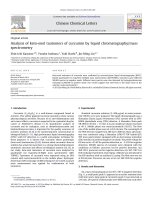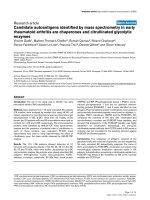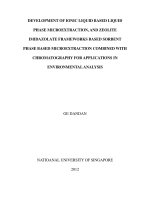Investigation and application of liquid chromatography mass spectrometry in the analysis of polar, less volatile and thermal unstable organic pollutants in environmental and biological samples 1
Bạn đang xem bản rút gọn của tài liệu. Xem và tải ngay bản đầy đủ của tài liệu tại đây (685.1 KB, 43 trang )
1. Chapter One
Introduction & Literature Review
1.1 GENERAL INTRODUCTION TO LIQUID CHROMATOGRAPHY-MASS
SPECTROMETRY (LC-MS)
In recent decades, LC-MS has experienced impressive progress, both in terms of
technological development and application. The combination of chromatography (for
separation) and mass spectrometry (as a sensitive detector that provides structural
information) has proved to be a primary technology for the detection and characterization
of various molecules, providing the analytical chemist with one of the most powerful
analytical tools of modern times. The key advantages of LC-MS are [1]:
¾ Selectivity: LC-MS is not constrained by chromatographic resolution.
coeluting peaks can be isolated by “mass selectivity.”
¾ Peak assignment: LC-MS creates a unique “chemical fingerprint” for the
compound of interest, ensuring correct peak assignment even in the presence
of interfering compounds.
¾ Molecular weight information: confirmation for known compounds,
identification for unknowns.
¾ Structural information: controlled fragmentation in LC-MS allows for
structural elucidation.
¾ Rapid method development: LC-MS can be used for the identification of
eluted analytes without retention time validation.
1
¾ Quantitation: quantitative and qualitative data can be obtained easily with
limited instrument optimization.
More importantly, with the development of atmospheric pressure ionization (API)
interface techniques, LC-API-MS has assumed great importance in the analysis of polar,
low volatile, and thermally instable organic compounds, for which direct analysis by GC-
MS is not possible [2].
1.2 INTRODUCTION AND BASIC PRINCIPLES
1.2.1 LC and MS
Liquid chromatography (LC) is a physical separation method by which the components to
be separated are selectively distributed between two immiscible phases: a liquid mobile
phase and a stationary phase bed through which the liquid mobile phase passes. The
chromatographic process occurs as a result of repeated sorption/desorption steps during
the movement of the analytes along the stationary phase. The separation is due to
differences in distribution coefficients of the individual analytes within the sample [3-6].
Because a high-pressure pump is required to move the mobile phase and analytes through
the column, LC is also known as high performance liquid chromatography (HPLC).
Mass spectrometry (MS), as one of LC detection techniques, has attracted growing
interest because of the potential to yield information on the relative molecular mass (Mr)
and the structure of the analyte, which cannot be found using other detection systems,
2
such as ultraviolet (UV), refractive index (RI) and fluorescence. At present, MS is the
most sensitive method of molecular analysis. MS is based on the detection of emitted
ions that have been separated or filtered according to their mass-to-charge (m/z) ratio.
The resulting mass spectrum is a plot of the relative abundance of the generated ions as a
function of the m/z ratio. Because extreme selectivity can be obtained, mass detection
combined with chromatographic separation is invaluable in quantitative trace analyses [7-
9].
1.2.2 LC-MS Coupling
1.2.2.1 General problems
When searching for a suitable technique for the analysis of mixtures that, often contain
unknowns and/or analytes in low concentration, the combination of chromatography (for
separation) with mass spectrometry (as detector that provides sensitive and structural
information) appears to be an obvious choice. However, liquid chromatography coupled
to mass spectrometry is an odd combination. In HPLC, the sample is in solution and at
atmospheric pressure, while the mass analysis of ions takes place within a vacuum [10].
In developing on-line LC-MS, three fundamental compatibility problems had to be
solved. Firstly, LC is preferred over gas chromatography (GC) in analysis of samples
with high polarity and low volatility. In contrast, one of the prerequisites for mass
spectrometric analysis is the formation of volatilized ions. Second difficult problem to be
solved was the necessity to eliminate the mobile phase. Water flowing at a rate of 1
3
ml/min from a conventional 4.6-mm-ID LC column is converted into vapor (at
atmospheric pressure) at 1244 ml/min, which is far too much for standard MS vacuum
systems to handle. Third, salts and other additives within the mobile phase are often
involatile (e.g., phosphates, NaCl, etc.) [10].
1.2.2.2 General introduction of interface techniques
The aforementioned problems have been solved by the development of interface
techniques that: 1) transfer the analyte from the LC column to the MS ion source and
prepare the analyte for ionization, 2) cope with the solvent from the LC, 3) bridge the
pressure difference between column outlet and mass analyzer [11-16].
The first experiments that couple LC with MS date back to the late 1960s. The actual
breakthrough in the development of coupling techniques was the introduction of the
moving-belt interface (MB) in 1974 that, became the first commercial LC-MS interface
[11]. Subsequently, many interface techniques have been rapidly developed, such as
particle beam (PB) [12], continuous flow fast atom bombardment (cf-FAB) [13,14],
direct liquid introduction (DLI) [15], thermospray (TSP) [16], and more recently, the API
technique (APCI and ESI) [16].
Both MB and PB interfaces rely on the removal of solvent prior to entering the MS [17].
MB separates the condensed liquid-phase side of the LC from the high vacuum of the MS
and uses a belt to transport the analytes from one to the other. The mobile phase of the
4
LC is deposited on a band and evaporated [18, 19]. Most moving-belt analyses deal with
volatile analytes, that consequently limit the application of MB LC-MS. The PB interface
provides the opportunity to use EI/CI without the mechanical transportation portion used
in MB [20]. The LC elutent is forced through a small nebulizer with the aid of following
He gas to form a stream of uniform droplets. These droplets move through a desolvation
chamber and evaporate, leaving a solid particle. These particles are separated from the
gas and transported into the MS source using a differentially pumped momentum
separator.
The PB interface can be considered as the successor of the MB, giving better
stability and more robustness. Furthermore, this is of growing importance in LC-MS
interfacing because relatively volatile analytes can be examined. Many pesticides are not
sufficiently volatile to be amenable to GC/MS, but can be analyzed by PB LC-MS. DLI
or cf-FAB interfaces reduce the flow entering the MS using a splitting device. A serious
drawback of this approach is the reduction in sensitivity caused by the split factor. The
flow rate magnitude, used with a classic 4.6 mm i.d. column (1 ml/min) is only tolerated
by techniques such as TSP and API. [21]
The TSP interface was developed by Vestal et al [22-24]. As the name thermospray
implies, heating of liquid flow leaving an LC system creates a spray of superheated mist
containing small liquid droplets. A major advantage of TSP over other LC-MS interfaces
is its ability to handle the high flow-rates delivered by LC (up to 2 mL/min). The TSP
interface was developed to solve two problems: 1) to reduce the pressure of the solvents,
and 2) generate ions of the analyte, that are frequently nonvolatile. This particular
interface was developed for a system that, for a number of years, was considered to be the
5
easiest, most versatile, and powerful LC-MS interface technique [23, 24]. However, with
the advent of new, more adaptable and robust LC-MS interfaces based on atmospheric-
pressure ionization (e.g., APCI and ESI), the use of TSP diminished rapidly [25].
1.2.2.3 API technique in LC-MS
The earliest LC-MS techniques (DLI, TSP, MB, and PB), though commercialized, were
often difficult to use, had limited sensitivity, and were not robust. However, they were
very useful for specific applications. The overwhelming increase in LC-MS applications
is primarily the result of the sensitivity and ruggedness of ESI and APCI, which are both
API techniques. The advantages of API techniques were summarized by Voyksner with
four key points [26]:
¾ API approaches can handle volumes of liquid typically used in LC,
¾ API is suitable for the analysis of non-volatile, polar, and thermally unstable
compounds typically analyzed by LC,
¾ API-MS systems are sensitive, offering comparable or better detection limits than
achieved by GC-MS,
¾ API systems are very rugged and relatively easy to use.
1.2.2.3.1 ESI
The first attempts to use electrospray (ES) as an MS interface date back to the late 1960s
and early 1970s. At that time, Dole et al investigated the possibility of producing gas-
6
phase ions from macromolecules in solution, utilizing an atmospheric pressure
electrostatic sprayer for analysis via ion mobility measurements [27-29]. The actual
origins of the LC–ES-MS coupling were reported in 1984, almost simultaneously by
Yamashita and Fenn and Aleksandrov et al [30-32]. Yet, the real breakthrough of ESI in
the early 1990’s relied on extremely low flow-rates that, introduced protein solutions at
the concentration of pmol/µl into the mass spectrometer [33, 34]. This breakthrough has
revolutionized the applications of MS, especially in biological and environmental
analyses [35, 36].
The ES process can be divided into three stages: droplet formation, droplet shrinkage and
gaseous ion formation [37]. The ES process is shown in Fig. 1-1 [38], here the liquid
flows from the HPLC column, enters a small caliber stainless steel capillary (maintained
at a voltage of 3000±4000 V), and are then dispersed into a very fine spray of charged
droplets with the same polarity. The solvent then evaporates, shrinking the droplet size
and increasing the charge concentration at the droplet's surface. Eventually, at the
Rayleigh limit, Coulombic repulsion overcomes the droplet's surface tension and the
droplet explodes. This “Coulombic explosion” forms a series of smaller, less charged
droplets. The process of shrinking immediately followed by explosion is repeated,
leading to very small (3–10 nm) charged droplets that are capable of producing gas-phase
ions, which gives a very soft ionization technique. The ions are sampled through a set of
skimmer electrodes and finally analyzed in the MS analyzer.
7
Fig. 1-1. Droplets and ion production under ES conditions [39].
In contrast with all other LC-MS combinations, ESI appears to be a concentration-
sensitive device; that is, the response is directly proportional to the concentration of the
analyte entering the source, irrespective of the flow-rate at which it is delivered. This
allows miniaturization of the technique without a loss in sensitivity.
Another interesting characteristic of ESI is its “softness.” Specifically, very labile
structures can be carried as ions into the gas phase without disrupting their structures. For
the same reason, ESI spectra contain little to no structural information because of the
absence of fragmentation. Molecular weight information is obtained in the first instance.
If more structural information is needed (e.g., sequence information of peptides),
fragmentation must be induced. This is most conveniently done by applying tandem MS.
8
There are many reasons for the predominant use of ESI: ease of operation, sensitivity,
reliability, robustness, and expanded areas of application. ESI is a highly efficient
ionization technique that has greatly extended the analytical potential of MS [35], and its
interface is currently the most widely applied method for liquid introduction into an MS.
Additionally, ESI is especially suited for the analysis of compounds ionized in the liquid
phase, due to the fact that, the observed ions, generally formed by protonation or
deprotonation of the molecule or by adduct formation with solvent ions, directly reflect
acid-base equilibrium in solution.
ESI is a mild ionization technique that efficiently produce protonated (or deprotonated)
molecular ions of polar, non-volatile, high molecular mass, and themolabile compounds.
Therefore, LC-ESI-MS is now widely used for the analysis of polar and small ionic
molecules, high molecular-weight proteins, and other biomacromolecules [38].
1.2.2.3.2 APCI
The exploration of APCI for LC-MS started in the early 1970s with the research work of
Hornning et al. on the use of a modified plasma chromatograph-MS combination [40].
Further research by the same group led to an APCI source, equipped with either a
63
Ni
foil or corona discharge needle as the primary source of electrons used to generate
reactant ions [41]. The vaporizer for sample and solvent was a heated glass tube filled
with a plug of glass wool, directly attached to a small APCI source. APCI interface
techniques were proven to be fully developed only after Fenn et al [42], demonstrated
9
rapid and accurate molecular-mass determination for large proteins by means of ESI. At
present, APCI is commercially available and a growing interest in applications involving
biological and environmental analysis.
In an APCI source, the column effluent is nebulized in a heated vaporizer tube (350-500
°C), where solvent evaporation is nearly complete. The gas-vapor mixture enters an
atmospheric-pressure ion source, wherein analyte ionization is initiated within a corona
discharge needle. The solvent vapor acts as reagent gas. At atmospheric pressure, the ions
are extracted and moved into the mass spectrometer by the exactly same set of skimmers
used for electrospray (Fig. 1-2) [43,44].
Fig. 1-2. Schematic diagram of the typical layout of an APCI source [45]
Ionization occurs through a corona discharge (Fig. 1-3), creating reagent ions from the
solvent vapor. Chemical ionization of the sample molecules is very efficient when at
atmospheric pressure, due to the high collision frequency. The moderate influences of
10
solvent clusters and high-pressure gas exposure on the reagent ions, reduced
fragmentation during ionization and results in primarily molecular ions.
Fig. 1-3. Schematic diagram of ionization in APCI-MS [46]
In APCI, positive and negative chemical ionization modes are often used. Proton transfer
(protonation [M+H]
+
reactions) occurs in the positive mode, and either electron transfer
or proton transfer (proton loss, [M-H]
-
) occurs in the negative mode. [M+H]
+
or [M-H]
-
are usually formed to give molecular weight information and structural information is
obtained through fragmentation induced in the source by increasing the cone voltage [47,
48].
In the positive ionization mode, an electron beam passes across methane-filled ion
source, methane being the reagent gas. (see Fig. 1-4). Interaction of methane (CH
4
) with
electrons (e
-
) yields methane molecular ions (CH
4
•+
). Newly formed ions collide several
times with neutral molecules (CH
4
) to give carbonium ions (CH
5
+
). The substance (M) to
be investigated is vaporized in the ion source where it collides with these ions (CH
5
+
).
Proton exchange usually occurs because the organic substance (M) is a stronger base than
CH
4
; hence, protonated molecular ions (MH
+
or better [M+H]
+
) are formed.
11
Fig. 1-4. Formation of reactive ions (CH
5
+
) from methane (CH
4
) reagent gas and their reaction
with sample molecules (M) to form protonated molecular ions MH
+
[49].
In the negative ionization mode, negative ions are formed by deprotonation (Fig. 1-5).
Ions of reagent gas, such as OH
-
or O
•-
, are strongly basic and capable of extracting a
proton from sample molecules M to give [M-H]
-
ions, one mass unit less than the true
molecular mass. Negative ion CI is a useful and sensitive technique for substances having
a high electron affinity, such as halogenated compounds or polycyclic aromatic
hydrocarbons.
Fig. 1-5. Negative reactant gas ions, O
•-
and OH
-
may be produced easily from (a) NO and (b)
NO/CH
4
, respectively [49].
In comparison to ESI, APCI allows for the use of solvents that are unfavourable for ion
formation because the solvent-evaporation and ion-formation processes are separated in
APCI. These low-polarity solvents are commonly used in normal-phase LC in
conjunction with low polarity samples that can generally be evaporated for APCI
ionization. Another major difference between APCI and ESI can be found in the LC
flow-rates that are used. APCI is a technique with optimal performance at high flow-rates
12
(up to 2 ml/min), while ESI flow rates must be less than 1 ml/min. When flow-rates are
too low, however, controlling the stability of the corona discharge may become
problematic. Whereas ESI is ideally suited to miniaturization, reducing the flows and LC
dimensions using APCI is much more laborious.
APCI is widely used to analyze relatively non-polar, semi-volatile samples of less than
1200 Daltons and it is an especially good ionization source for LC. The analytes should
have some degree of volatility and should not be too thermolabile. Typical molecules are
pesticides, drugs, steroids, etc. [50-54]. Currently, LC-APCI-MS is often used in various
stages of drug analysis, environmental analysis of pesticides and herbicides (in water, air,
and soil), and metabolite studies.
1.3 SAMPLE PREPARATION TECHNIQUES
1.3.1 General Introduction
The development of a complete analytical method includes sample storage, sample
preparation, analyte separation, identification and quantitation. Among these, sample
preparation is the most tedious and time-consuming step, and usually the source of
imprecision and inaccuracy of the overall analysis.
Currently, chromatography combined with various existing detection systems is the most
common analytical technique used for the separation and determination of pesticide
13
residues in environmental and biological samples. In order to obtain qualitative and
quantitative information on the presence of trace levels of pesticides from various
complicated solid matrices such as soils, food, animals and plants, optimized sample
preparation is necessary prior to chromatography analysis.
The conventional extraction techniques used for solid matrices are mainly Soxhlet
extraction, and sonication. Soxhlet extraction has some advantages: it allows for the use
of large sample amount, and no filtration is required after the extraction. Nonetheless,
significant amounts of solvents, which are often toxic and flammable, are needed and the
procedure itself is tedious and time-consuming. Sonication is faster than Soxhlet
extraction and enables one to extract large amounts of sample at a relatively low cost
[55]. Still, it uses about as much solvent as Soxhlet extraction, is labor intensive, and
filtration is required after extraction. In recent years, some novel extraction techniques for
solid matrices such as supercritical fluid extraction (SFE), microwave-assisted extraction
(MAE) and accelerated-solvent extraction (ASE), have attracted growing interest as they
are less time-consuming, environmentally friendlier, and smaller volumes of solvents.
The principles, advantages and disadvantages of the above mentioned extraction
techniques for solid matrices are summarized in Table 1-1 [56,57].
14
Table 1-1
Preparation techniques for solid matrices-principles, advantages and disadvantages [56,57]
Extraction
techniques
Principles Advantages Disadvantages
Soxhlet Sample is placed in an extraction thimble and
leached with hot solvent in a Soxhlet extractor
for 12-24h. Solvent evaporation/concentration
is done separately.
Standard method
Large amount of sample (10-30g)
Filtration not required
Not matrix dependent
Low cost
Long extraction time, up to 24-48 hrs
High consumption of hazardous solvents
(300-500 ml)
Sonication Fast (30-60min)
Large amount of sample (10-30g)
Not matrix dependent
Low cost
High consumption of hazardous solvents
(300-500 ml)
Labor intensive
Filtration required
Exposure to solvent vapor
Supercritical
fluid
extraction
(SFE)
Sample is placed in a high-pressure cartridge or
chamber and extracted with supercritical fluid
(e.g., carbon dioxide at pressures of 150 to
450atm and temperatures of 40 to 150°C). After
depressurization, analytes are collected in a
small volume of organic solvent or on a trap.
Fast (30-60min)
CO2 is nontoxic, nonflammable, and
environmentally friendly
Small amount of solvent (5-10 ml)
Filtration not required
No solvent exposure
Limited sample size (< 10g)
Matrix dependent
High cost
Microwave-
assisted
extraction
(MAE)
Sample is placed in an open-or closed vessel,
immersed in solvent, and heated with
microwave energy
1) Fast (4-30min)
2) Small amount of solvent (10-30ml)
3) Full control of extraction parameters
(time, power, temperature)
4) Stirring possible
5) Higher temperatures
6) 12-14 samples can be processed
simultaneously.
Extracts must be filtered
Polar solvent needed
Accelerated
Solvent
Extraction
(ASE)
Sample is extracted using solvent at elevated
temperature and pressure, fully automated
1) Short extraction time
2) use less extraction fluid
3) be readily be automated
high capital cost
15
16
1.3.2. Microwave-assisted Extraction (MAE)
1.3.2.1 Basic principle of MAE
The principle of MAE is based on heating the extractants (mostly liquid organic solvents)
in contact with the sample with microwave energy [58]. Partitioning of the analytes of
interest from the sample matrix to the extractant depends on the efficiency of microwave
heating and the nature of the extractant.
Microwave energy is a non-ionizing radiation (frequency 300 - 3×10
5
MHz) that causes
molecular motion by migration of ions and rotation of dipoles. Dipole rotation refers to
alignment, owing to the electric field, of molecules in the solvent and samples that have
dipole moments (either permanent or induced by the electric field). As the field
decreases, thermal disorder is restored which results in thermal energy being released. At
2450 MHz (the frequency used in commercial systems), alignment of the molecules
followed by their return to disorder occurs 4.9 x 10
9
times per second, resulting in rapid
heating [59].
In order to absorb microwave energy, the solvent must exhibit dielectric polarization.
The greater the dielectric constant, the more thermal energy is released and the more
rapid is the heating at a given frequency. Besides the absorption of microwave energy,
the efficiency of the solvent converting it into heat is also important, which is expressed
by the dielectric loss factor. In fact, the dielectric constant and the dielectric loss factor of
17
a certain solvent can differ greatly. Therefore, the overall efficiency of heating using
microwave energy is always given by the dissipation factor (Tan δ = ε″ / ε′), which is the
ratio of the sample’s dielectric loss (i.e. the loss factor ε″) to its dielectric constant (ε′)
[60, 61]. The dielectric constant is a measure of the sample’s ability to absorb microwave
energy while the loss factor is the ability to dissipate the absorbed energy. Molecules and
ionic solutions (usually acids) will absorb microwave energy easily because they have a
permanent dipole moment that is affected by the microwaves. On the other hand, non-
polar solvents such as hexane will not heat up when exposed to microwaves radiation. In
Table 1-2, selected physical parameters, including dielectric constants and dissipation
factors, are shown for solvents that are used in more than 90% of the applications [62,
63].
Unlike classical heating, microwave radiation heats the entire sample simultaneously
without heating the vessel. Thus, the solution reaches its boiling point very rapidly,
especially in a closed system, and the solvent can be heated to above its boiling point at
atmospheric pressure. This leads to very short extraction times and high extraction
efficiency. Table 1-3 shows the comparison of the boiling points of solvents in an open
system and closed vessel. From Table 1-3, we also can see that there is no heating under
microwave irradiation in some non-polar compounds such as hexane, cyclohexane, and
petroleum ether
[64].
18
Table 1-2. Dielectric constant, dielectric loss factors and dissipation factors of different materials
at a frequency 3 GHz and a temperature 25°C [63]
Material
ε′ ε″
tan δ x 10
4
Ice 3.2 0.00288 9
Water 76.7 12.0419 1570
Methanol 23.9 15.296 6400
Ethanol 6.5 1.625 2500
n-Propanol 3.7 2.479 6700
Ethylene glycol 12.0 12 10 000
Carbon tetrachloride 2.2 0.00088 4
Heptane 1.9 0.00019 1
Monochlorobiphenyl 2.75 0.28325 1030
Trichlorobiphenyl 2.72 0.1088 400
Hexane 1.80 - -
Calcium titanate 163.0 0.3749 23
Pentachlorobiphenyl 2.70 0.01188 44
Table 1-3. Comparison of the boiling points of solvents in open and closed systems [64]
Solvent
Boiling point (°C)
in open system
Boiling point (°C)
in closed system (175psi)
Dichloromethane 39.8* 140
Acetone 56.2* 164
Methanol 64.7* 151
Ethanol 78.3* 164
Acetonitrile 81.6* 194
2-Propanol 82.4* 145
Acetone:Hexane 1:1 v/v 52 156
Acetone: Cyclohexane 70:30 v/v 52 160
Acetone: Petroleum ether 1:1 v/v 39 147
19
1.3.2.2 Parameter’s influence on the extraction process
The optimization of MAE conditions for extraction purposes has been investigated by
many researchers. The most commonly studied parameters are solvent composition,
solvent volume, extraction temperature, extraction time and matrix characteristics
(including water content) [65, 66].
A correct choice of solvent is paramount to optimization of the extraction process. When
selecting a solvent, consideration should be given to the microwave-absorbing properties
of the solvent, the interaction of the solvent with the matrix, and the analyte solubility in
the solvent. Preferably, the solvent should have a high selectivity towards the analyte of
interest, excluding unwanted matrix components. Another important aspect is the
compatibility of the extraction solvent with the analytical method used for the final
analysis step. Optimal extraction solvents cannot be deduced directly from those used in
conventional procedures. If the solvent molecule is unable to absorb microwave energy
there will be no heating, and hence no effective extraction [67, 68].
The amount of solvent needed for a single sample is often between 10–30 ml [69]. In
some cases, solvent volume may be an important parameter for efficient extractions. The
solvent volume must be sufficient to ensure that the entire sample is immersed, especially
when utilizing a matrix that will absorb solvent and swell during the extraction process
[70].
20
The most investigated parameter in MAE is extraction temperature, not surprisingly,
since the temperature is an important factor contributing to increased recoveries, not only
for MAE but for all extraction techniques. When MAE is conducted in closed vessels, the
temperature may reach well above the boiling point of the solvent. These elevated
temperatures result in improved extraction efficiencies, since desorption of analytes from
active matrix sites will increase. Additionally, solvents have a higher capacity to
solubilize analytes at higher temperatures. Likewise, surface tension and solvent viscosity
decrease with temperature, thus improving sample wetting and matrix penetration,
respectively.
Extraction times in MAE are short compared to conventional techniques. Normally, 10
min is sufficient, for the case of extraction of organic pollutants [71, 72], but even 3 min
has been demonstrated to give full recovery for pesticides from soils and sediments [73,
74]. In the extraction of sulfonylurea herbicides from soils, it was demonstrated that
increasing the extraction time from 5 to 30 min did not adversely affect the recovery [75].
With thermolabile compounds, however, long extraction times may result in degradation,
which was reported for the extraction of pesticides [76]. This was observed in the present
work (see below): the extraction of carbamates pesticides from soil, wherein the
recoveries of some carbamates decrease with increasing extraction times, while other
analytes were unaffected.
The nature of the matrix, in which the analytes of interest are bound, can have a profound
effect on the recoveries of compounds. This has been illustrated by spiking experiments,
21
where solid samples were spiked with the analytes of interest, and compared with
extractions from native soils. In almost all cases higher recoveries were obtained from the
spiked samples, demonstrating the effect of the stronger binding to the matrix in native
samples [77]. Furthermore, in many cases the matrix moisture improves the extraction
recoveries because the matrix moisture will always have an effect on the microwave-
absorbing ability, and hence facilitate the heating process.
1.3.2.3 Main applications of MAE to environmental samples
In 1986, Ganzler et al. were the first to report the use of microwave energy to irradiate
solid matrices such as soil, seeds, foods, and feeds in the presence of extracting solvents
with high dipole moments [78, 79]. They applied the same solvents as normally used in
Soxhlet extraction. Between 0.5 and 1 g of sample was extracted in 2-3 ml of solvent for
less than 5 min of irradiation in a common kitchen microwave oven. This was the starting
point for numerous laboratories to study the analytical possibilities of MAE in
environmental applications. In the past few years, MAE has been successfully applied for
simultaneous extraction of toxic organic contaminants, such as polycyclic aromatic
hydrocarbons (PAHs), polychlorinated biphenyls (PCBs), phenols and pesticides from
various solid matrices (e.g., soils, sediments, and atmospheric particles). Some selected
closed-vessel MAE applications of organic contaminants are summarized in Table 1-4.
22
Table 1-4. Selected publications related to MAE of pesticides
Analytes Matrix Solvent Temperature
(°C)
Extraction
Time
Recovery
(%)
Reference
Method
Ref.
PAHs Standard
reference
soils and
sediments
Hexane–
acetone
(1:1)
115 10 min 65-115 Certified
values.
compared to
Soxhlet,
sonication
and SFE
71,
80
PAHs Standard
reference
and native
sediments
Hexane–
acetone
(1:1)
115 5 min 75-135 Certified
values.
compared to
Soxhlet
81
PAHs Native,
contaminate
d soil
Acetone 120 20 75-105 Soxhlet.
FMASE, and
SFE
82
PCBs Standard
reference
soil and
sediments
Hexane–
acetone
(1:1)
115 10 min 70-110 Certified
values.
compared to
Soxhlet
83,
84
PCBs Standard
reference
soil
Hexane–
acetone
(1:1)
155 5 min 87-107 Certified
values.
compared to
Soxhlet
85
PAHs, PCBs Standard
reference
soil and
sediment
Hexane–
acetone
(1:1)
115 10 min 70-125 Certified
values
86
Organochlorine
pesticides
(OCPs)
Spiked
sediments
Hexane–
acetone
(1:1)
100 10 min 71-93 Soxhlet 87
OCPs Freshly
spiked and
aged soil
samples
Hexane–
acetone
(1:1)
115 20 min 70-105 - 88
OCPs,
Organophosphate
pesticides(OPPs)
Freshly
spiked and
aged soil
samples
Hexane–
acetone
(1:1)
115 10 min 80-120
Soxhlet and
sonication
83
23
OCPs, OPPs and
other pesticides
Spiked sea
and tap
water (e.g.,
MAE
elution of
SPE discs)
Acetone 100 5 min 63-98 Conventional
liquid–liquid
extraction
89
Dichlorodipheny
l-trichloroethane
(DDT)
Native,
contaminate
d sediment
Toluene–
water (1:1)
No control 6 min 100-103 Soxhlet 90
DDT Fatty fish
tissue
Ethyl
acetate–
cyclohexane
(1:1)
No control
7 × 30
80 Conventional
liquid
extraction
method.
91
OCPs, Triazines,
etc.
Spiked soil
sample
Hexane–
acetone
(1:1)
115 10 min 85-125 - 86
Triazines Freshly
spiked and
aged soils
DCM–
Methanol
(9:1)
115 20 min 89-103 Conventional
extraction
method
92
Phenylureas Freshly
spiked and
aged soils
DCM–
Methanol
(9:1)
70 10 min 93-109 - 93
Hexaconazole Native,
contaminate
d soil
Acetone 115 15 min 53-102 Soxhlet and
SFE
94
Dimethomorph Aged field-
treated soil
Acetonitrile
–water (9:1)
125 3 min 54 Sonication 95
Phenols Spiked soils Acetone-
hexane
(4:1)
130 10 min 89-104 - 96
1.4 ENVIRONMENTAL APPLICATIONS OF LC-MS FOR THE ANALYSIS OF
TRACE AMOUNTS OF POLAR, LOW-VOLATILE, AND THERMALLY
LABILE ORGANIC COMPOUNDS
One of the most critical environmental issues that have emerged over the last few decades
is the impact of pollution on our environment. GC-MS is widely used as the primary
method in environmental analysis [97-101]. Yet, many of the target pollutants, such as
pesticides (herbicides) and their degradation products are polar, low volatile, and
24
thermally labile organic compounds that prevent direct analysis by GC-MS.
Consequently, LC-MS, especially in combination with the soft ionization technique LC-
API-MS, has held the preeminent position in the analysis of trace amount these pollutants
from the environment.
1.4.1 Pesticides in Aqueous Environment
For many years, the use of pesticides in agriculture has given rise to concern with the
unintended effects on the environment and public health. Pesticides enter environmental
waters through net loss of soil via poor agricultural practices and water-logging of
irrigated land. The sea, rivers, and lakes have become the immediate environmental
reservoir for all possible pesticides. Thus, the monitoring of trace levels of pesticides and
their degradation products in environmental waters is necessary. [102, 103]
The powerful features of LC–MS, such as efficient separation, identification, and
quantification of polar analytes, make this technique very attractive to the field of
pesticide residue analysis [104, 105]. Spliid et al. reported the application of LC-APCI-
MS for the determination of many different types of pesticide, such as triazines,
phenylurea herbicides, acetanilides, organophosphorus insecticides, etc., from ground
water in 1996. The limits of detection (LOD) for water samples were in the range of
0.001 to 0.005 ng/l [106]. Crescenzi and DiCorcia et al. found 45 widely used pesticides
contained in various waters (drinking water, groundwater, and river water) by using LC-
ESI-MS [107]. Furthermore, so-called “difficult” pesticides such as phosphonic acid
25
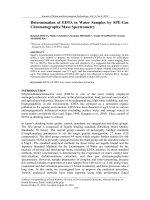
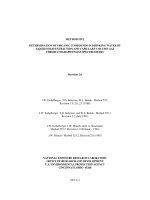
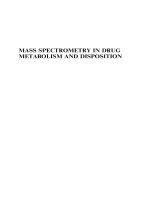
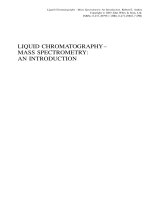
![niessen - liquid chromatography - mass spectrometry 3e [lcms] (crc, 2006)](https://media.store123doc.com/images/document/14/ne/ea/medium_eaq1401870789.jpg)
